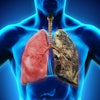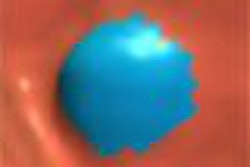Most of the recent advances in CT have focused on creating high-resolution anatomical images from thin-section data. Functional research has largely been relegated to the sidelines.
But a new experiment is especially promising in its use of functional CT to fill a real clinical need. Researchers were able to accurately measure the kidney's glomerular filtration rate (GFR) in pigs using electron beam CT (EBCT). They found excellent correlation between renal time-attenuation curves (TACs) and inulin clearance measurements in two of three mathematical formulas tested.
In doing so, they have begun to solve a difficult measurement problem.
"In patients with asymmetric renal diseases -- such as renal artery stenosis, ureteral obstruction, or renal atrophy -- measurement of single-kidney glomerular filtration rate is critical because changes in the plasma creatinine level or in inulin clearance do not reflect the functional impairment of individually affected kidneys," wrote Elena Daghini and colleagues from the Mayo Clinic College of Medicine in Rochester, MN. "The reference standard for measurement of renal function, inulin clearance, cannot be used to assess single-kidney GFR without invasive ureteral catheterization. Furthermore, alternative methods to derive an index of single-kidney function, such as renal scintigraphy, are only semiquantitative" (Radiology, February 2007, Vol. 242:2, pp. 325-326).
Earlier studies showed the feasibility of estimating GFR on EBCT using a gamma variate model, while Patlak and Blasberg used real-time attenuation curves, the authors wrote. "To our knowledge, GFR, as derived with the model of Patlak and Blasberg, has not been directly compared with inulin clearance," Daghini and colleagues wrote.
The study aimed to compare three mathematic models for assessing GFR on EBCT images in pigs, with concurrent inulin clearance serving as the reference standard.
The researchers measured inulin levels in nine pigs (weight, 30-70 kg), and compared the results in 18 kidneys with single-kidney GFR assessed from real-time attenuation curves before and after the infusion of vasodilator acetylcholine.
The pigs were given only water for 12 hours before the study, and were anesthetized with 500 mg ketamine and xylazine, then intubated and mechanically ventilated. Heparin in saline was administered intravenously.
Scanning began three seconds after bolus injection of the low-osmolar contrast agent iopamidol (Isovue-370, Bristol-Myers Squibb Medical Imaging, North Billerica, MA). The kidneys were scanned in multisection flow mode on an EBCT scanner (GE Healthcare, Chalfont St. Giles, U.K.), yielding two 8-mm-thick CT sections through the hilar region.
"A 40-mL primer bolus of 2% inulin was administered through the venous sheath and followed with constant infusion at a rate of 1 mL/min and with collection of urine from a bladder catheter," the authors wrote.
Forty consecutive scans were acquired both before and during the last half of a 20-minute fusion of acetylcholine (4.5 µg), given to induce vasodilation and increase GFR, the authors explained. The renal study was followed by a flow study in which the kidneys were scanned from pole to pole in continuous volume scanning mode using 6-mm sections. Iopamidol (0.5 mL/kg) was infused over five seconds to sustain corticomedullary differentiation.
The team examined reconstructed images on a workstation (Ultra-80, Sun Microsystems, Mountain View, CA) using the Analyze analytical software (Biomedical Imaging Resource, Mayo Clinic, Rochester, MN). ROIs were traced in the opacified peripheral zone in the cortex and the enclosed area of the medulla.
GFR was calculated with both the original and modified Patlak methods, and with a more complicated but previously validated extended gamma variate modeling of first-pass cortical time attenuation curves, the authors explained.
"The Patlak method was developed to determine the permeability of the blood-brain barrier by estimating the rate of contrast accumulation while it is temporarily trapped in the tissues," they explained. Adapted to the kidneys, the original Patlak method used an ROI that covered the entire kidney including the medulla, while in the modified Patlak method the ROI included only the cortex, where glomerular filtration occurs. The third method, the gamma variate model, has been shown to be applicable and reproducible by means of comparison with a reference standard, the report noted.
The results showed that GFR measured with the original Patlak method was poorly correlated with inulin clearance, while GFR measurements using a modified Patlak method (p < 0.001, r = 0.75) and with gamma variate modeling (p < 0.001, r = 0.79) were significantly correlated with inulin clearance, and further showed an increase in response to acetylcholine administration.
"Nonetheless, the Bland-Altman plot, which was used to examine concordance between two measurements of the same physiologic parameter, showed some overestimation of the GFR at high filtration rates with both CT methods when compared with inulin clearance," the authors added. "This might have been due to a concurrent increase in tubular contrast agent concentration secondary to filtration and proximal fluid reabsorption."
Only two levels were selected to represent each kidney due to relative uniformity of the organ in pigs compared to humans. But EBCT can be used to scan up to eight CT levels (8 cm of renal tissue) almost simultaneously, making feasible the evaluation of segmental disease, they noted.
Modifications that account for renal anatomy "can improve the utility of CT techniques for minimally invasive estimation of single-kidney GFR," the authors wrote. If the Patlak method is to be used for measuring GFR, "special consideration should be given to regional renal structure and function and to flow dynamics within the kidney."
"Despite greater overestimation of GFR, the relative simplicity and potential clinical usefulness of the modified Patlak method may offer some advantage over gamma variate modeling, which may be more accurate but is more time-consuming," they wrote.
"Further studies are needed to test this method in humans and validate the utility of alternative modalities (e.g., helical CT, magnetic resonance imaging, and positron emission tomography) for this approach in the assessment of single-kidney GFR," the authors wrote.
In an accompanying editorial, Dr. F. Graham Sommer from the Stanford University Medical Center in Stanford, CA, said it is easy to imagine a number of uses for the technique once potential inaccuracies have been addressed.
Promising applications would include the assessment of single-kidney function as part of a CT angiography exam, "since several authors have suggested that kidneys that have only a moderate decrease in renal function are those that are most likely to benefit from revascularization," Sommer wrote. "Similarly, when partial or complete nephrectomy is being planned because of a tumor, knowledge of bilateral single-kidney renal function would be valuable when deciding on appropriate treatment."
More research will be needed to find the best techniques, but the findings "hold promise that the noninvasive estimation of human single-kidney GFR with CT is possible," he added. "A single CT examination combining excellent morphologic and accurate functional information would provide a powerful noninvasive tool for renal diagnosis."
By Eric Barnes
AuntMinnie.com staff writer
February 8, 2007
Related Reading
Maternal vitamin A status may influence kidney size in newborn, January 9, 2007
Nephropathy similarly low after iopamidol and iodixanol, November 10, 2006
Part II: Palliative steps prevent contrast-induced nephropathy, September 20, 2006
Part I: Identifying patients at risk of contrast-induced nephropathy, September 13, 2005
N-acetylcysteine reduces incidence of contrast-induced nephropathy, June 29, 2006
Copyright © 2007 AuntMinnie.com



















